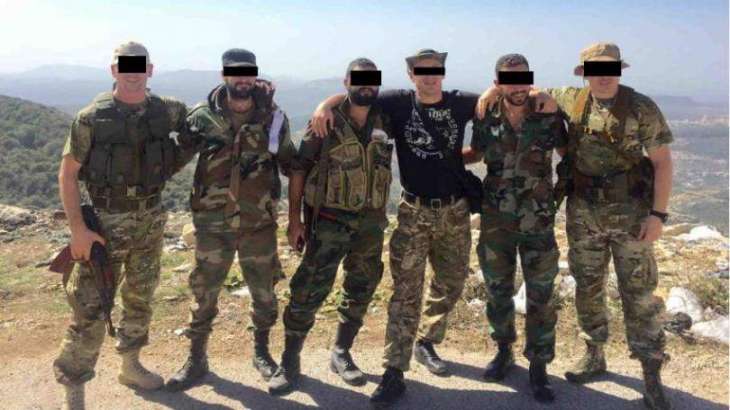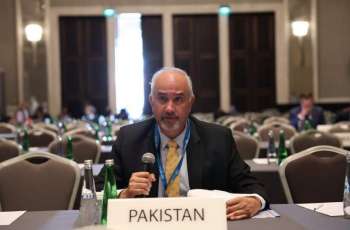Russia's defense industry reached numerous milestones in 2018, from having advanced weapons delivered to the Russian army, to long-awaited contracts being signed, the largest maneuvers in modern Russian history being held and S-300 air defense systems being delivered to Syria
MOSCOW (Pakistan Point News / Sputnik - 05th January, 2019) Russia's defense industry reached numerous milestones in 2018, from having advanced weapons delivered to the Russian army, to long-awaited contracts being signed, the largest maneuvers in modern Russian history being held and S-300 air defense systems being delivered to Syria.
One of this year's main events for Russia's defense industry was President Vladimir Putin's presentation of the nation's advanced weapons, the development of which had until then been shrouded in absolute secrecy.
As part of his address to the Federal Assembly on March 1, Putin revealed information about a number of new, state-of-the-art weapons: the Kinzhal hypersonic missile system, which is installed on MiG-31BM interceptor aircraft; Avangard hypersonic missile system; Burevestnik nuclear-powered cruise missile; underwater drone Poseidon; and Peresvet laser weapon.
According to the president, the development of some of these weapons began once it became clear that the United States was not ready to compromise, in particular, on the deployment of its missile defense systems close to Russian borders.
The Avangard system, a fundamentally new type of weapon that launches missiles capable of traveling intercontinental distances in dense layers of the atmosphere at speeds faster than Mach 20, was developed in order to bypass the US missile defense system. It is expected that Avangard will be supplied to the Russian armed forces either by the end of this year or early next year.
Another breakthrough was the underwater drone Poseidon, which is unmatched anywhere else in the world. Poseidon is capable of operating at great depths and moving several times faster than all existing ships, nuclear-powered cruise missiles and even a potential hypersonic missile. According to Putin, these drones could carry both conventional and nuclear warheads, which would allow them to hit a wide range of targets, including aircraft carrier groups, coastal fortifications and infrastructure.
However, it is not only the unique combat capabilities that distinguish this equipment from other weapons. For the first time the Names for these new weapons were chosen by popular vote on the official website of the Russian Defense Ministry.
Although the information about these new weapons prompted skepticism in some media and among foreign experts, Russia's defense industry repeatedly showed off its state-of-the-art weapons throughout the year while also presenting results of tests involving said weapons. According to Russian Defense Minister Sergei Shoigu, the state armament program for 2018-2027 would be revised to ensure that the armed forces would receive these weapons.
The list of advanced weapons Russia came out with in 2018 was not limited to those presented by Putin in March. Earlier this month, Russia completed tests of the Penicillin artillery reconnaissance complex, which some foreign media have already called a threat to US artillery.
Penicillin is designed to search for the firing position of artillery guns, mortars, multiple rocket launchers and launching positions of anti-aircraft and tactical missiles while simultaneously adjusting the firing of its own artillery. At the same time, according to the developers of this system, state corporation Rostec's Roselectronika Holding, the system receives and processes signals from enemy fire, calculating their location in less than five seconds.
Moreover, in late September, it became known that the modern Nabrosok artillery system was under development. It consists of Drok mortar and self-propelled Floks (Phlox) guns and will replace the Sani heavy mortar system, which is currently in service with the Russian armed forces.
The advantage of the new complexes is their autonomy � they are mounted on a wheeled or tracked chassis, unlike Sani, which is transported by a truck or a trailer.
In addition to new weapons, long-term defense industry projects continued to develop successfully this year. The Defense Ministry successfully conducted ejection tests, or pop-up launch tests, of the Sarmat intercontinental ballistic missile, which will replace the Voevoda intercontinental ballistic missiles. Sarmat is expected to be put into service in 2020.
The outgoing year will also be marked by Russia signing long-awaited weapons delivery contracts, which have been the focus for foreign media and the professional community over the past few years.
One such deal, for the purchase of two pre-production prototypes of the Su-57 fifth generation fighter jet, was finalized by the Russian Defense Ministry on the sidelines of the Army-2018 defense industry forum. The first of the two aircraft will be delivered to the Russian armed forces in 2019. In addition, the ministry signed a contract with the United Aircraft Corporation to be supplied with six new multirole MiG-35 fighters by 2023.
Apart from the aircraft contracts, the ministry signed a deal for the delivery of 132 next-generation T-14 battle tanks and T-15 heavy infantry fighting vehicles that are based on the Armata heavy military tracked vehicle platform.
In addition, the Defense Ministry and the Moscow Institute of Thermal Technology signed a contract to develop the Anchar-RV long-range hypersonic "aerial vehicle." Details of the design and timeline of the project were not disclosed � it is only known that the project has already progressed from the theoretical stage to the experimental design stage. It has not been revealed yet whether the Anchar is an aircraft or a missile, but the institute is famous for its Bulava submarine-launched ballistic missiles.
Syria's air defenses were reinforced this year by Russian S-300 air defense systems. The reason for this was the tragic event that occurred on September 17, when a Russian Il-20 military plane was downed by a missile launched by a Syrian S-200 air defense system while the latter was repelling an air raid by Israeli F-16 jets in Latakia.
The Russian Defense Ministry blamed the crash on the Israeli Air Force, arguing that the Israeli jets used the Russian aircraft as a shield against Syrian air defense systems.
In the wake of the incident, Russia decided to equip command posts of Syrian air defense systems with automated control systems and carry out radio electronic suppression of satellite navigation and onboard communications systems of combat aircraft attempting to attack Syria. Most importantly, however, Moscow said it would deliver S-300 systems to Syria.
According to Shoigu, four S-300 launchers were delivered to Damascus. In addition, Russia promised to train Syrian servicemen to operate the new air defense systems.
The annual Vostok military drills took place on September 11-17 in the Russian Far East, and in the waters of the Sea of Japan, the Bering Sea and the Sea of Okhotsk. These large-scale military exercises, which involved all branches of the armed forces, became the largest maneuvers in the modern history of Russia.
More than 300,000 troops; over 1,000 aircraft, helicopters and unmanned aerial vehicles; up to 36,000 tanks, armored personnel carriers and other combat vehicles; and up to 80 ships and support vessels were involved in these exercises. In addition to Russian land, air and naval forces, Chinese and Mongolian troops also took part in one of the stages. Beijing sent more than 3,200 troops, 900 pieces of equipment, six jets and 24 helicopters from its military to participate in combat training activities.
Following the maneuvers, Putin, who is the commander-in-chief of the Russian Armed Forces, addressed the military and noted that Vostok-2018 had shown that the military was ready to confront serious military threats.
The creation of the Main Military and Political Administration (GVPU) can also be considered one of the main achievements of the outgoing year. It was created at the end of July and reminded many in Russia of the main political administration of the Soviet army.
Col. Gen. Andrei Kartapolov, appointed as the head of the administration, said, however, that the new system of military and political activity in modern Russia would be fundamentally different from the Soviet and post-Soviet models of military education.
The formation of the GVPU consists of three stages. The first stage, which completed on October 1, was the development of central structures, while the second, finalized on December 1, saw the creation of a system of political and military activity among troops. The third stage will start in September 2019 and will include the training of personnel for the GVPU at the Defense Ministry's military academies.
The year of 2018 has seen a number of landmark events with regard to defense industry cooperation. For example, after several years of negotiations, Russia and India signed an over $5 billion contract to deliver S-400s. The deal became the largest in the history of Russian state arms exporter Rosoboronexport. Payments for these systems will be made in rubles.
In addition, Moscow and New Delhi signed a batch of other contracts, including on the supply and production of Russian Project 11356 frigates in India. The details of these deals have not been revealed, but according to unofficial data, one contract for the delivery of two Russian-built vessels is worth about $950 million. Russia's United Shipbuilding Corporation expects to deliver the first two frigates to India within three years.
The contracts are not the only development in this field. A defense industry source told Sputnik in late November that Russia and its man-portable air defense system Igla won a tender in India to deliver $1.5 billion worth of short-range air defense systems. There has been no formal confirmation on the matter so far.
As for the industry's general prospects, according to Rosoboronexport Director General Alexander Mikheev, the global demand for Russian weapons is growing, with the company's order volume exceeding $55 billion. A significant proportion of these orders are contracts signed with Arab states. In the outgoing year, Rosoboronexport signed contracts worth about $19 billion to supply arms abroad, which is almost 25 percent more than in 2017.
Military science has been constantly evolving. In June, president Putin signed a decree creating the Era military science park in the southern city of Anapa. It is scheduled to begin fully operating in late 2019. According to the Defense Ministry, the park's work will focus on eight main areas in its initial stage: IT-systems and artificial intelligence systems; robotic systems; supercomputers; technical vision and pattern recognition; information security; nanotechnologies and nanomaterials; energy, technologies and life-support machines; and bioengineering, biosynthetic and biosensor technologies.
The first portion of the science park opened in September, after which the selection of the best innovative projects began. It is expected that Era will provide about 2,000 new jobs by 2020 � almost 1,300 apartments along the coast have already been prepared for specialists. According to the Defense Ministry, science park workers will be provided with all possible amenities, including a large modern laboratory complex, and research and production shops.
Some 37 enterprises, including Concern Kalashnikov and Sukhoi Civil Aircraft Company, as well as some research start-up teams, have already moved to the laboratory cluster. Together, they have already begun implementing 48 projects in robotics, energy, bioengineering, information systems and other areas.
In September, the foundation stone for the Main Cathedral of the Russian Armed Forces was laid in the Patriot military park in the Moscow Region. The cathedral is planned to be finished by 2020 in time for the 75th anniversary of victory in the Great Patriotic War (1941-1945).
The cathedral is designed in the monumental Russian-Byzantine style � it will be 81.5 meters (267 feet) wide and 113.7 meters long.
The cathedral will become a spiritual, educational and teaching center for military personnel, Orthodox priests and ordinary Russians. A school of military priests and the institute of the sisters of mercy will also be established there.
It is noteworthy that the cathedral's construction will be funded by voluntary donations by military personnel, their families, as well as all any person or organization that wishes. A special charitable foundation has been created to raise donations.
The Road of Memory gallery, dedicated to the history of the Great Patriotic War, will run along the perimeter of the cathedral complex. Based on digital technologies, the gallery will present the names and photographs of everyone who fought in the war, and its visitors will be able to access this information themselves if they have the name or year of birth of the person they're looking for.




